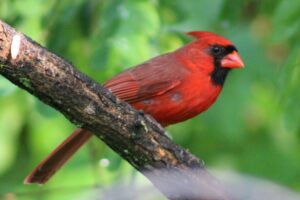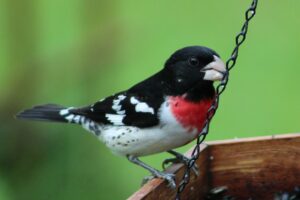By volunteer
 Summer has given way to autumn. It’s that beautiful time of year when leaves start changing and nearly everyone that writes about birds decides to talk about migration. A fascinating subject for sure but I’m going to address another aspect of bird behavior. Heading south for the coming winter is nice, but not everyone can afford to be a “snow bird”. What about all of the “staycationers”?
Summer has given way to autumn. It’s that beautiful time of year when leaves start changing and nearly everyone that writes about birds decides to talk about migration. A fascinating subject for sure but I’m going to address another aspect of bird behavior. Heading south for the coming winter is nice, but not everyone can afford to be a “snow bird”. What about all of the “staycationers”?
In Kentucky, we have around sixty species of birds that do not migrate. They are here all year. Of these yearly residents, about a dozen or so are commonly seen visiting our backyard feeders. Perhaps the most easily recognized and probably the most widely known of these is the Northern Cardinal.
This question recently appeared on a bird related Facebook page: “Every year, late summer the Cardinals disappear. Can anyone explain this?” So, where did they go? To answer this question we need to take a look at what’s going on in the world around us. The Cardinals are not alone in their disappearance.
The start of fall is not just about falling temperatures and pretty leaves. It also marks the end of the growing season. Crops are being harvested. People are filling root cellars and canning. It is a time of plenty. Not just for us; you could say everything is going to seed. In nature, this is a good thing. Trees are full of fruits and nuts. Shrubs are bent with the weight of ripe berries. And wild flowers and grasses are laden heavily with seeds.
Have you ever gone to an all you can eat buffet? Did you choose to only eat the peas, or only the green beans? Of course you didn’t. That would be silly.
Take a walk through some natural areas and just watch. You will notice the Cardinals and others enjoying the feast that nature has laid out. All of the berries and nuts and seeds provide a smorgasbord of dining choices for the bird with a discriminating palate. In fact, Cardinals have a need to eat berries in addition to seeds. Berries provide the carotenoids necessary to maintain their bright red plumage. And bright red feathers lead to breeding success in the Spring.
 You should still keep your feeders clean and filled with fresh suet and seed. As I mentioned back in February, some birds will be starting to stash food for the coming winter. Remember those tricky Nuthatches? They will be stopping by to grab something to go. Additionally, because as everyone is pointing out, it is migration season; your feeding area can be a much-needed rest stop and refueling station for the long distance traveler. As a reward for your attention, you may get to see something new or different. I look forward to seeing the Rose-Breasted Grosbeaks every year as they make their brief stops on the way south. After the passers through, we can also look forward to the arrival of our winter guests.
You should still keep your feeders clean and filled with fresh suet and seed. As I mentioned back in February, some birds will be starting to stash food for the coming winter. Remember those tricky Nuthatches? They will be stopping by to grab something to go. Additionally, because as everyone is pointing out, it is migration season; your feeding area can be a much-needed rest stop and refueling station for the long distance traveler. As a reward for your attention, you may get to see something new or different. I look forward to seeing the Rose-Breasted Grosbeaks every year as they make their brief stops on the way south. After the passers through, we can also look forward to the arrival of our winter guests.
Finally, keep this thought in mind. When nature’s buffet starts getting less well stocked (it is a limited time offering after all), your regulars will be back.
–Jim Scout, Volunteer Naturalist

